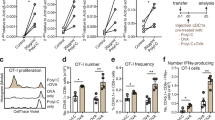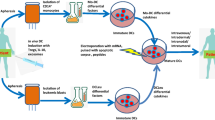Abstract
The identification of the most efficient strategy for tumor antigen loading of dendritic cells (DCs) remains a challenge in cancer immunotherapy protocols. Autologous dead tumor cells have been demonstrated to constitute an acceptable source of multiple tumor-associated antigens (TAA) to pulse DCs. However the optimal approach for inducing cell death that would lead to effective endocytosis and activation of DCs remains controversial. In this study we have induced and defined 3 distinct mechanisms of tumor cell death (apoptosis, necrosis and fusion-mediated cell death), and investigated their differential effects on DCs. Bone marrow-derived DCs demonstrated comparable uptake of primary apoptotic, necrotic, or fused dead tumor cells. Furthermore, the distinct modes of cancer cell death had analogous potential in activating the transcription factors NF-κB and STAT1 and in maturing DCs, resulting in an equally effective stimulation of immune T cells. The current study therefore provides further informations on the use of dead whole tumor cells as antigen sources for effective active anti-cancer immunotherapy.
Similar content being viewed by others
References
Banchereau J, Steinman RM (1998) Dendritic cells and the control of immunity. Nature 392:245–252
Gallucci S, Lolkema M, Matzinger P (1999) Natural adjuvants: endogenous activators of dendritic cells. Nat Med 5:1249–1255
Nestle FO, Alijagic S, Gilliet M et al (1998) Vaccination of melanoma patients with peptide- or tumor lysate-pulsed dendritic cells. Nat Med 4:328–332
Schuler G, Steinman RM (1997) Dendritic cells as adjuvants for immune-mediated resistance to tumors. J Exp Med 186:1183–1187
Ashley DM, Faiola B, Nair S, Hale LP, Bigner DD, Gilboa E (1997) Bone marrow-generated dendritic cells pulsed with tumor extracts or tumor RNA induce antitumor immunity against central nervous system tumors. J Exp Med 186:1177–1182
Fields RC, Shimizu K, Mule JJ (1998) Murine dendritic cells pulsed with whole tumor lysates mediate potent antitumor immune responses in vitro and in vivo. Proc Natl Acad Sci USA 95:9482–9487
Geiger C, Regn S, Weinzierl A, Noessner E, Schendel DJ (2005) A generic RNA-pulsed dendritic cell vaccine strategy for renal cell carcinoma. J Transl Med 3:29
Phan V, Errington F, Cheong SC et al (2003) A new genetic method to generate and isolate small, short-lived but highly potent dendritic cell-tumor cell hybrid vaccines. Nat Med 9:1215–1219
Sauter B, Albert ML, Francisco L, Larsson M, Somersan S, Bhardwaj N (2000) Consequences of cell death: exposure to necrotic tumor cells, but not primary tissue cells or apoptotic cells, induces the maturation of immunostimulatory dendritic cells. J Exp Med 191:423–434
Van Der Bruggen P, Zhang Y, Chaux P et al (2002) Tumor-specific shared antigenic peptides recognized by human T cells. Immunol Rev 188:51–64
Wolfers J, Lozier A, Raposo G et al (2001) Tumor-derived exosomes are a source of shared tumor rejection antigens for CTL cross-priming. Nat Med 7:297–303
Albert ML, Sauter B, Bhardwaj N (1998) Dendritic cells acquire antigen from apoptotic cells and induce class I-restricted CTLs. Nature 392:86–89
Albert ML, Pearce SF, Francisco LM et al (1998) Immature dendritic cells phagocytose apoptotic cells via alphavbeta5 and CD36, and cross-present antigens to cytotoxic T lymphocytes. J Exp Med 188:1359–1368
Schnurr M, Scholz C, Rothenfusser S et al (2002) Apoptotic pancreatic tumor cells are superior to cell lysates in promoting cross-priming of cytotoxic T cells and activate NK and gammadelta T cells. Cancer Res 62:2347–2352
Jarnjak-Jankovic S, Pettersen RD, Saeboe-Larssen S, Wesenberg F, Olafsen MR, Gaudernack G (2005) Preclinical evaluation of autologous dendritic cells transfected with mRNA or loaded with apoptotic cells for immunotherapy of high-risk neuroblastoma. Cancer Gene Ther 12:699–707
Basu S, Binder RJ, Suto R, Anderson KM, Srivastava PK (2000) Necrotic but not apoptotic cell death releases heat shock proteins, which deliver a partial maturation signal to dendritic cells and activate the NF-kappa B pathway. Int Immunol 12:1539–1546
Bateman AR, Harrington KJ, Kottke T et al (2002) Viral fusogenic membrane glycoproteins kill solid tumor cells by nonapoptotic mechanisms that promote cross presentation of tumor antigens by dendritic cells. Cancer Res 62:6566–6578
Linardakis E, Bateman A, Phan V et al (2002) Enhancing the efficacy of a weak allogeneic melanoma vaccine by viral fusogenic membrane glycoprotein-mediated tumor cell-tumor cell fusion. Cancer Res 62:5495–5504
Martin F, Caignard A, Jeannin JF, Leclerc A, Martin M (1983) Selection by trypsin of two sublines of rat colon cancer cells forming progressive or regressive tumors. Int J Cancer 32:623–627
Caignard A, Pelletier H, Martin F (1988) Specificity of the immune response leading to protection or enhancement by regressive and progressive variants of a rat colon carcinoma. Int J Cancer 42:883–886
Bonnotte B, Larmonier N, Favre N et al (2001) Identification of tumor-infiltrating macrophages as the killers of tumor cells after immunization in a rat model system. J Immunol 167:5077–5083
Grauer O, Wohlleben G, Seubert S, Weishaupt A, Kampgen E, Gold R (2002) Analysis of maturation states of rat bone marrow-derived dendritic cells using an improved culture technique. Histochem Cell Biol 117:351–362
Talmor M, Mirza A, Turley S, Mellman I, Hoffman LA, Steinman RM (1998) Generation or large numbers of immature and mature dendritic cells from rat bone marrow cultures. Eur J Immunol 28:811–817
Melcher A, Todryk S, Hardwick N, Ford M, Jacobson M, Vile RG (1998) Tumor immunogenicity is determined by the mechanism of cell death via induction of heat shock protein expression. Nat Med 4:581–587
Vile RG, Nelson JA, Castleden S, Chong H, Hart IR (1994) Systemic gene therapy of murine melanoma using tissue specific expression of the HSVtk gene involves an immune component. Cancer Res 54:6228–6234
Larmonier N, Billerey C, Rebe C et al (2002) An atypical caspase-independent death pathway for an immunogenic cancer cell line. Oncogene 21:6091–6100
Ghiringhelli F, Larmonier N, Schmitt E et al (2004) CD4+CD25+ regulatory T cells suppress tumor immunity but are sensitive to cyclophosphamide which allows immunotherapy of established tumors to be curative. Eur J Immunol 34:336–344
Basu S, Binder RJ, Ramalingam T, Srivastava PK (2001) CD91 is a common receptor for heat shock proteins gp96, hsp90, hsp70, and calreticulin. Immunity 14:303–313
Melcher A, Gough M, Todryk S, Vile R (1999) Apoptosis or necrosis for tumor immunotherapy: what’s in a name? J Mol Med 77:824–833
Somersan S, Larsson M, Fonteneau JF, Basu S, Srivastava P, Bhardwaj N (2001) Primary tumor tissue lysates are enriched in heat shock proteins and induce the maturation of human dendritic cells. J Immunol 167:4844–4852
Todryk SM, Melcher AA, Dalgleish AG, Vile RG (2000) Heat shock proteins refine the danger theory. Immunology 99:334–337
Feng H, Zeng Y, Graner MW, Katsanis E (2002) Stressed apoptotic tumor cells stimulate dendritic cells and induce specific cytotoxic T cells. Blood 100:4108–4115
Feng H, Zeng Y, Graner MW, Likhacheva A, Katsanis E (2003) Exogenous stress proteins enhance the immunogenicity of apoptotic tumor cells and stimulate antitumor immunity. Blood 101:245–252
Feng H, Zeng Y, Whitesell L, Katsanis E (2001) Stressed apoptotic tumor cells express heat shock proteins and elicit tumor-specific immunity. Blood 97:3505–3512
Banchereau J, Palucka AK (2005) Dendritic cells as therapeutic vaccines against cancer. Nat Rev Immunol 5:296–306
Scheffer SR, Nave H, Korangy F et al (2003) Apoptotic, but not necrotic, tumor cell vaccines induce a potent immune response in vivo. Int J Cancer 103:205–211
Jarnjak-Jankovic S, Pettersen RD, Saeboe-Larssen S, Wesenberg F, Gaudernack G (2005) Evaluation of dendritic cells loaded with apoptotic cancer cells or expressing tumour mRNA as potential cancer vaccines against leukemia. BMC Cancer 5:20
Bonnotte B, Favre N, Moutet M et al (2000) Role of tumor cell apoptosis in tumor antigen migration to the draining lymph nodes. J Immunol 164:1995–2000
Chaux P, Favre N, Martin M, Martin F (1997) Tumor-infiltrating dendritic cells are defective in their antigen-presenting function and inducible B7 expression in rats. Int J Cancer 72:619–624
Binder RJ, Vatner R, Srivastava P (2004) The heat-shock protein receptors: some answers and more questions. Tissue Antigens 64:442–451
Asea A, Rehli M, Kabingu E et al (2002) Novel signal transduction pathway utilized by extracellular HSP70: role of toll-like receptor (TLR) 2 and TLR4. J Biol Chem 277:15028–15034
Zeng Y, Feng H, Graner MW, Katsanis E (2003) Tumor-derived, chaperone-rich cell lysate activates dendritic cells and elicits potent antitumor immunity. Blood 101:4485–4491
Shi H, Cao T, Connolly JE et al (2006) Hyperthermia enhances CTL cross-priming. J Immunol 176:2134–2141
Kotera Y, Shimizu K, Mule JJ (2001) Comparative analysis of necrotic and apoptotic tumor cells as a source of antigen(s) in dendritic cell-based immunization. Cancer Res 61:8105–8109
Author information
Authors and Affiliations
Corresponding author
Additional information
Supported by grants from the French League against Cancer (National, Burgundy, and Nièvre Committees). N.L. received grants from the French National League against Cancer, and D.C. from the Saône et Loire League against Cancer. E.K. and N.L. received financial support from the NIH R01 grant CA104926.
Rights and permissions
About this article
Cite this article
Larmonier, N., Mérino, D., Nicolas, A. et al. Apoptotic, necrotic, or fused tumor cells: An equivalent source of antigen for dendritic cell loading. Apoptosis 11, 1513–1524 (2006). https://doi.org/10.1007/s10495-006-8765-0
Published:
Issue Date:
DOI: https://doi.org/10.1007/s10495-006-8765-0




